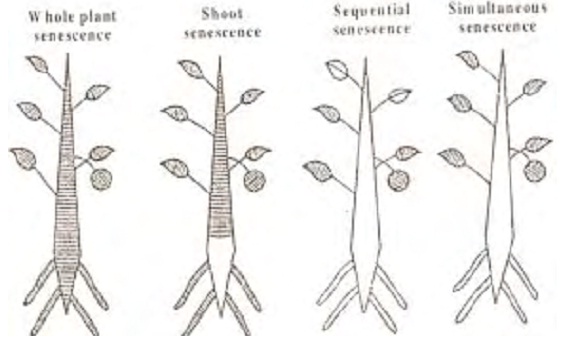The catastrophe theory
Mistakes at the translation and transcription level
- mRNA mistakes
- Missing of repair systems
- Cytokinins in the t-RNA adjacent to the anti-codon loop
- Nonsense protein formation (faulty translation)
Bad DNA multiplication
DNA repair potential decreases
DNA in dry tissue (seeds) more
susceptible to damage
mRNA life time changes
Changes at the DNA and RNA levels
oIncreases
of RNAses
oDecrease
of DNA-RNA polymerase
in an individual, the aging (senescence) occurs as a result of accumulation of errors committed by the molecular genetic apparatus during protein synthesis. It claims that when the amount of error product exceeds a certain threshold value; malfunction, senescence and death results. Although these mistakes can occur in any protein made by the cell, when these mistakes occur in the enzymes and other proteins responsible for synthesizing DNA and RNA, or in the protein synthesizing machinery itself, this could lead to an increasing cascade of errors, referred to as an "Error catastrophe".
The error could be at one or more sites along the protein production line, either at a transcriptional or translational level, resulting in the "nonsense proteins" acccumulate. These are non-functional enzymes containing mistakes in the amino acid sequence. This escalating process could turn what is initially a very low error rate in young individuals into a significant rate of accumulation of errors in older individuals, and one would predict that the rate of error accumulation might continue to increase exponentially throughout the life of the individual.
The genetic blueprint for each biological species occurs in the Deoxyribo nucleic acid (DNA) in the nucleus of each cell. When the cell divides, an enzyme known as DNA polymerase makes a new copy of the DNA by combining the appropriate building blocks known as deoxyribonucleotides in the correct sequence in a process known as DNA replication. The genetic sequences in the DNA are then transcribed by another kind of copying enzyme, known as RNA polymerase, into a ribonucleic acid (RNA) molecule called messenger RNA. Specific messenger RNAs contain the instructions for synthesizing individual proteins of the correct amino acid sequence, corresponding to the original blueprint in the DNA. This final protein synthesizing process is called translation.
During DNA replication, many DNA polymerases possess the ability to recognize mismatched bases, then back up and correct their own mistakes. In addition, very robust DNA repair systems are present to correct mistakes made during synthesis, or afterward by chemicals able to damage DNA. Thus, the error frequency in DNA replication is usually extremely low, perhaps less than one in a million bases. Studies to demonstrate age-related changes in the copying fidelity of polymerases or DNA repair capacity have not provided convincing support for the error catastrophe theory.
In general, RNA polymerases also combine ribonucleotide building blocks to make RNA with high sequence fidelity, but lower than that exhibited by DNA polymerases. However, the overall instability and turnover of messenger RNA tends to attenuate the impact of any mistakes made during messenger RNA synthesis. Protein synthesis is also generally carried out with high fidelity, and there is little evidence to suggest that this changes with age.
Gershon 1985, however challenged this theory and claimed that-
the process most prone to ageing is post-transcriptional protein folding and the most probable candidate being proteases. Erroneously folded non-functional proteases therefore lead to erratic cell metabolism and senescence.
Proteins do become randomly altered after they are synthesized; a variety of such processes is collectively referred to as post-translational modification because it occurs after synthesis of the protein and use of the messenger RNA as a template has been completed. Although distinct from the damage hypothesized in the original error catastrophe theory, post-translational modification of proteins could functionally resemble an error catastrophe. These modifications include oxidation of amino acid sidechains, racemization of certain amino acids, and condensation of the lysine side chain amino group with aldehyde groups such as those found in glucose. This latter process is known as non-enzymatic glycation. Biochemical mechanisms exist to repair the damage caused during some of these processes, suggesting they could have biological significance with implications for aging. However, there is a dearth of evidence unequivocally indicating that damage-inducing processes, damage accumulation, or repair processes are casually related to aging in mammalian species.
In summary, although altered proteins do accumulate with increasing age in mammals, the error catastrophe theory itself is no longer regarded as a viable theory. Nevertheless, there remains a healthy research interest in determining what roles damaged proteins, and the processes that either destroy the damaged protein or repair the damage, might play as casual factors in aging.

